Abstract
Roles for both the tripeptide, GSH, and individual amino acids in modifying the cellular response to oxygen deprivation-induced injury have been suggested by prior work in kidney and other tissues, but the precise interrelationships have not been clearly defined. We have studied the effects of GSH, its component amino acids, and related compounds on the behavior of isolated renal proximal tubules in a well characterized model of hypoxic injury in vitro. GSH, the combination of cysteine, glutamate, and glycine and glycine alone, when present in the medium during 30 min hypoxia, a duration sufficient to produce extensive irreversible injury in untreated tubules, were protective. Significant effects were detected at 0.25 mM concentrations of the reagents, and protection was nearly complete at concentrations of 1 mM and above. Glutamate and cysteine alone were not protective. The exogenous GSH added to the tubule suspensions was rapidly degraded to its component amino acids. Treatment of tubules with GSH or cysteine, but not glycine, increased intracellular GSH levels. Oxidized GSH was protective. Serine, N-(2-mercaptopropionyl)-glycine, and a panel of agents known to modify injury produced by reactive oxygen metabolites were without benefit. These observations identify a novel and potent action of glycine to modify the course of hypoxic renal tubular cell injury. This effect is independent of changes in cellular GSH metabolism and appears to be unrelated to alterations of cell thiols or reactive oxygen metabolites. Further elucidation of its mechanism may provide insight into both the basic pathophysiology of oxygen deprivation-induced cell injury and a practical way to ameliorate it.
Full text
PDF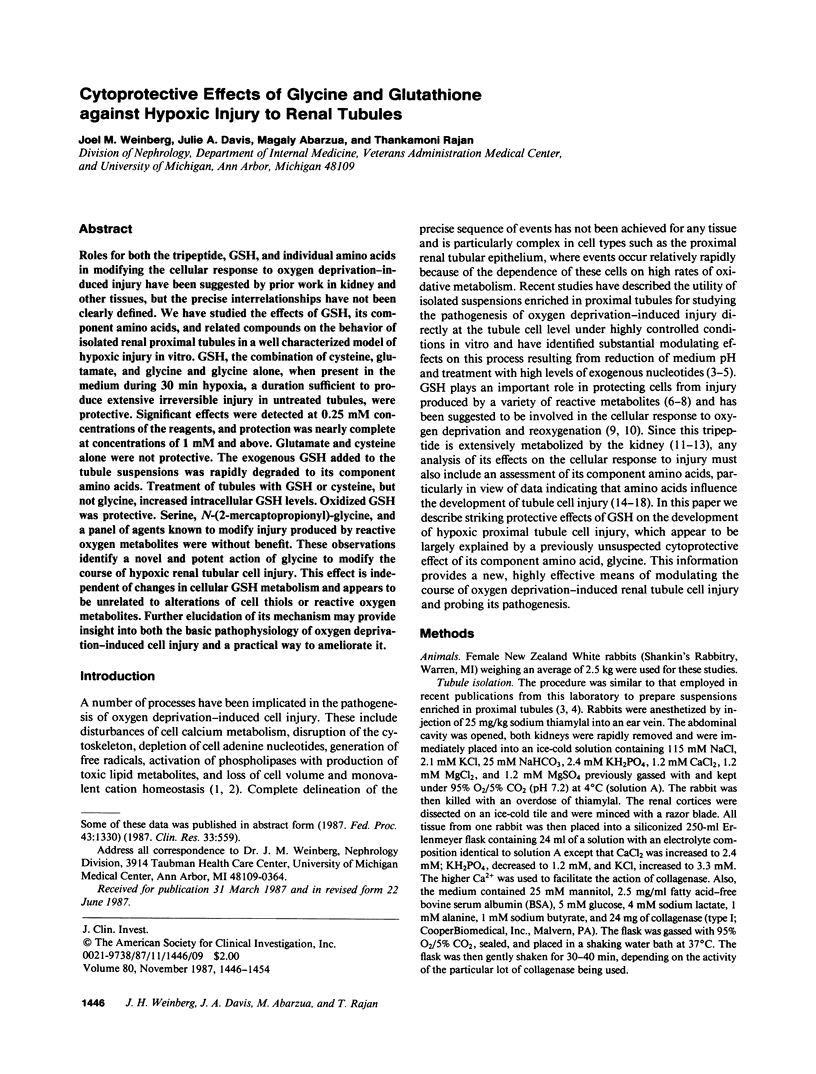
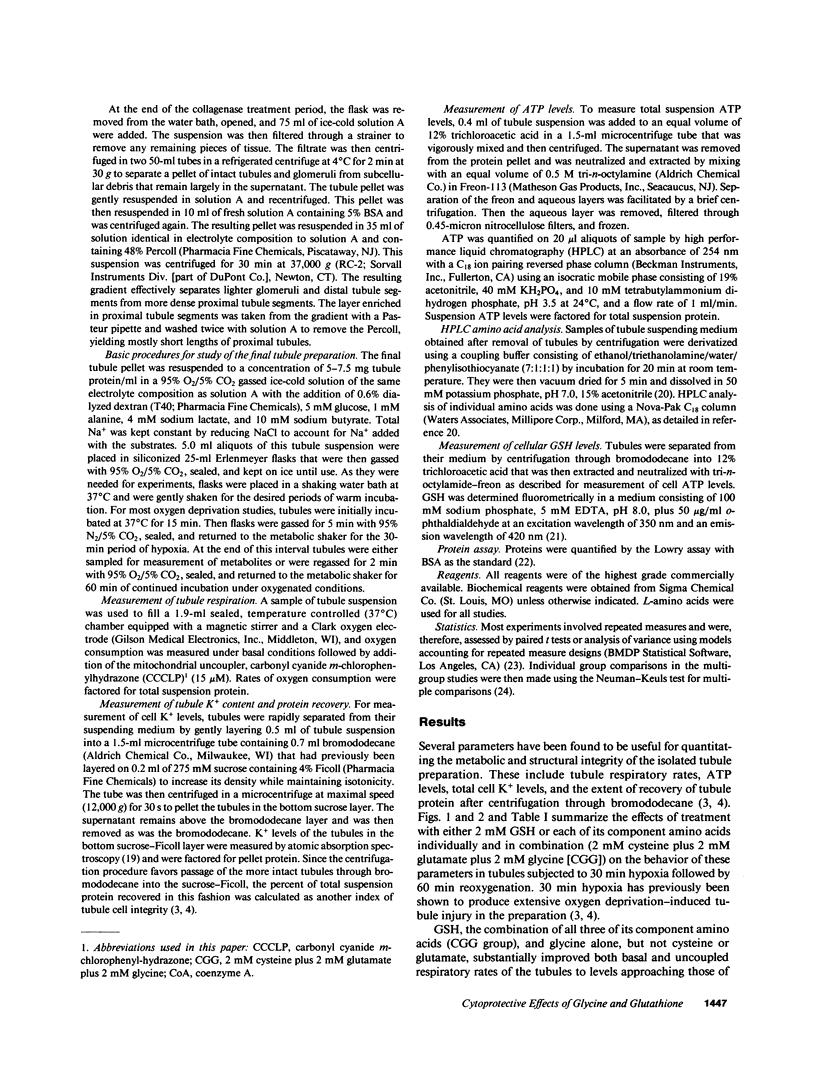
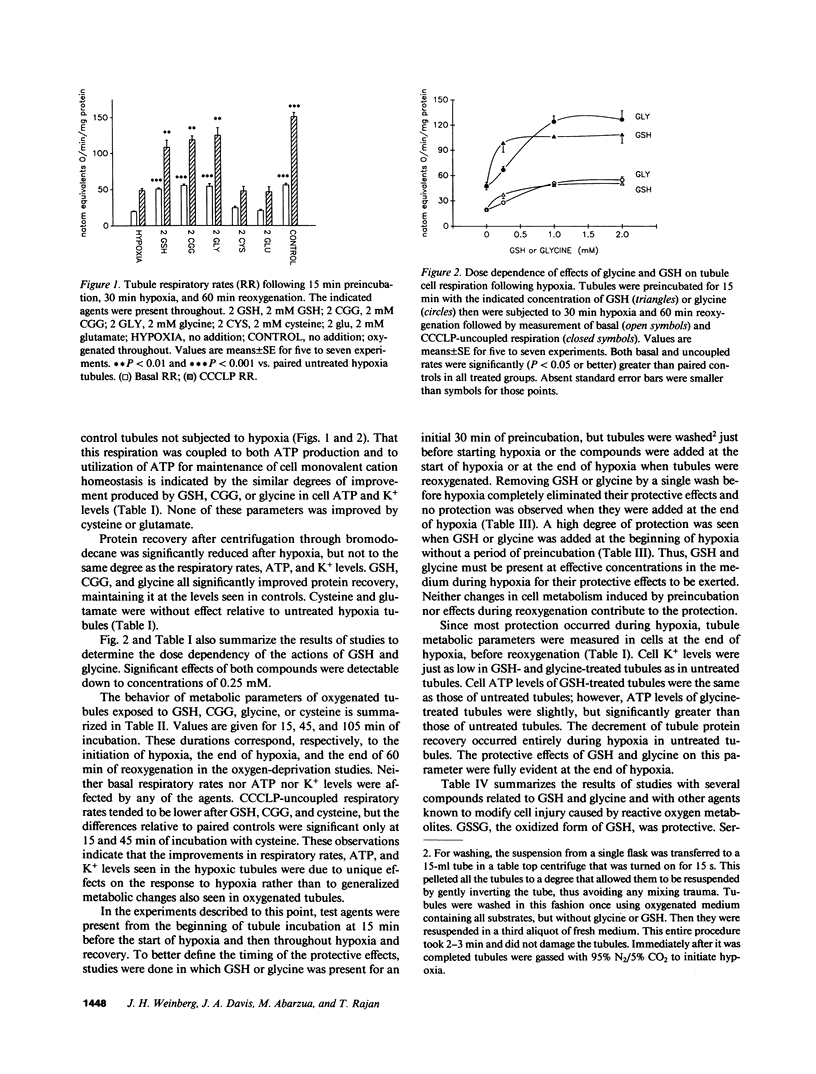
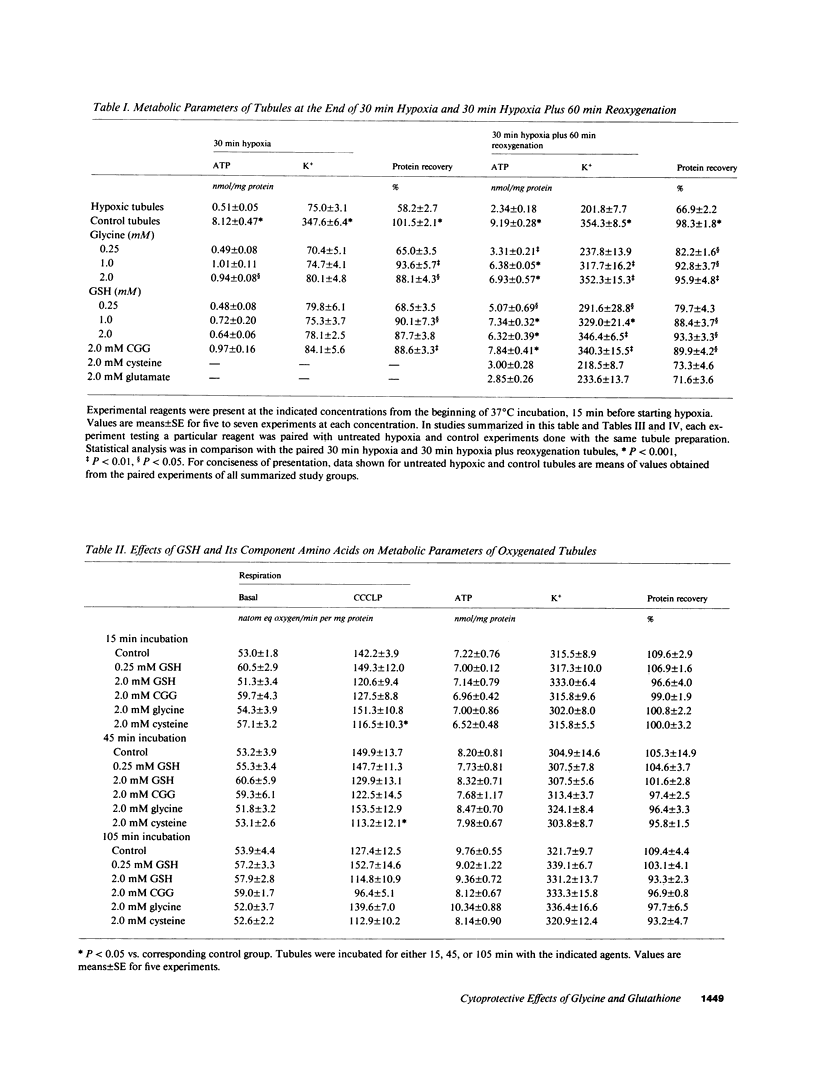
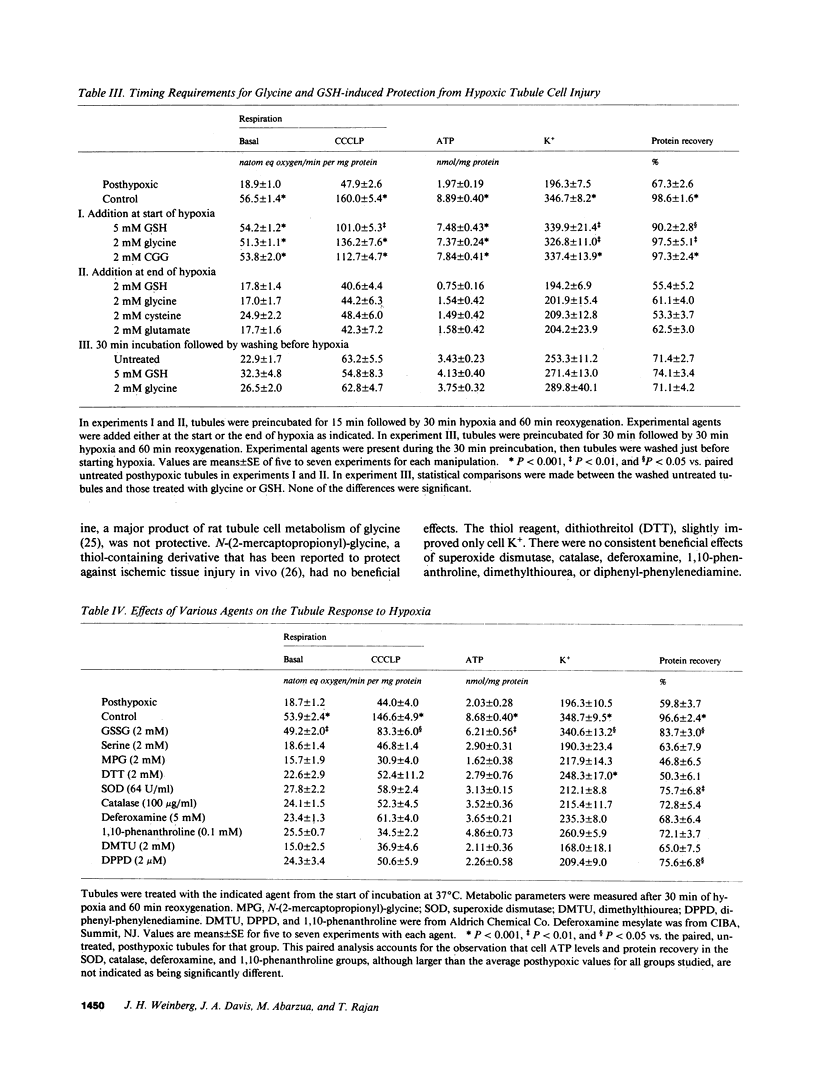
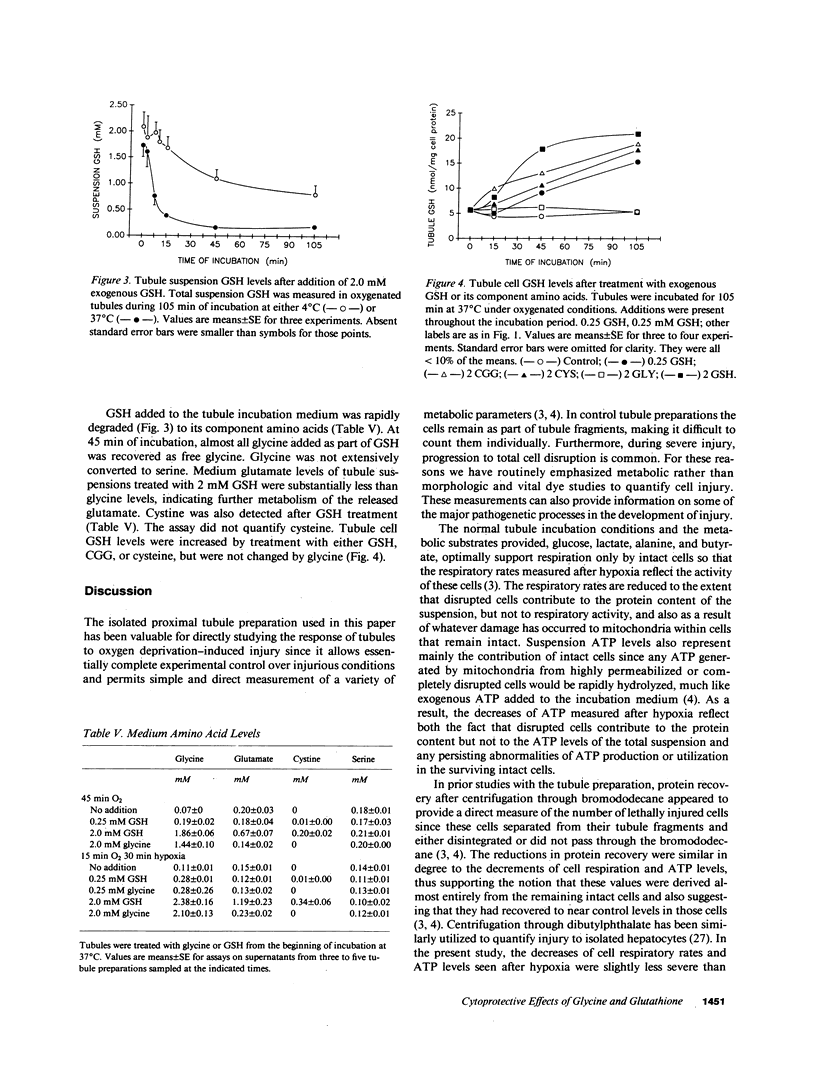
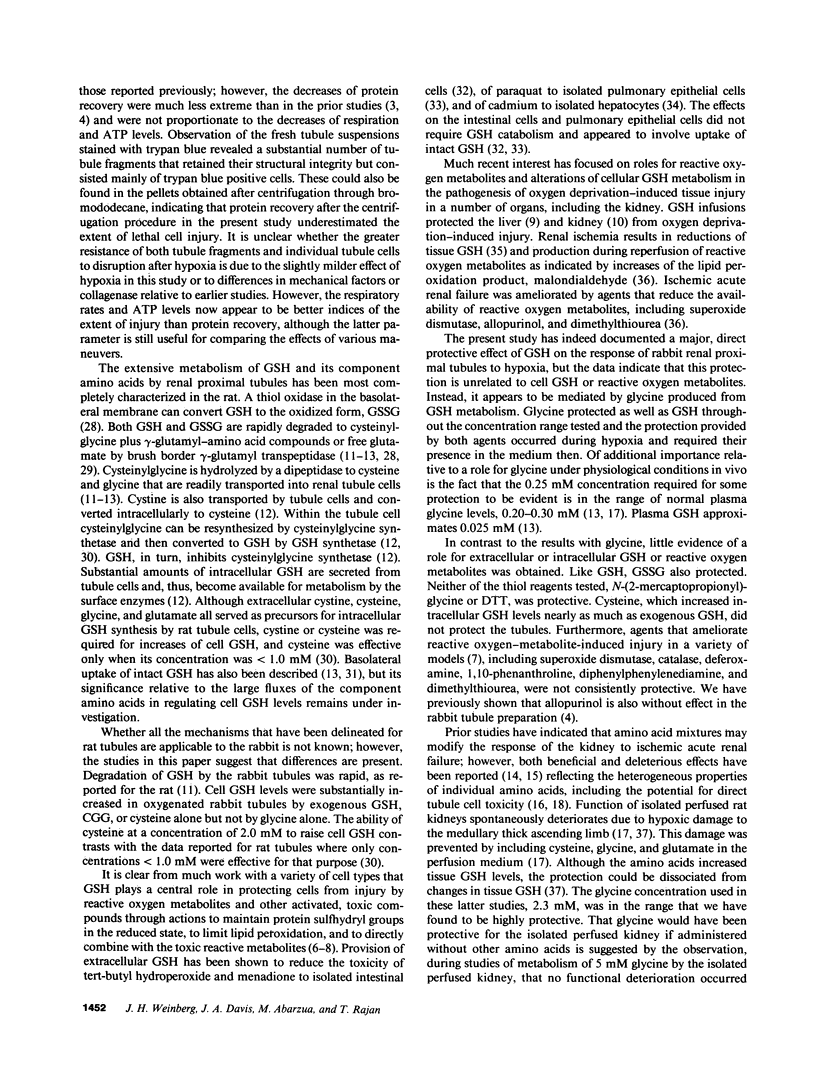
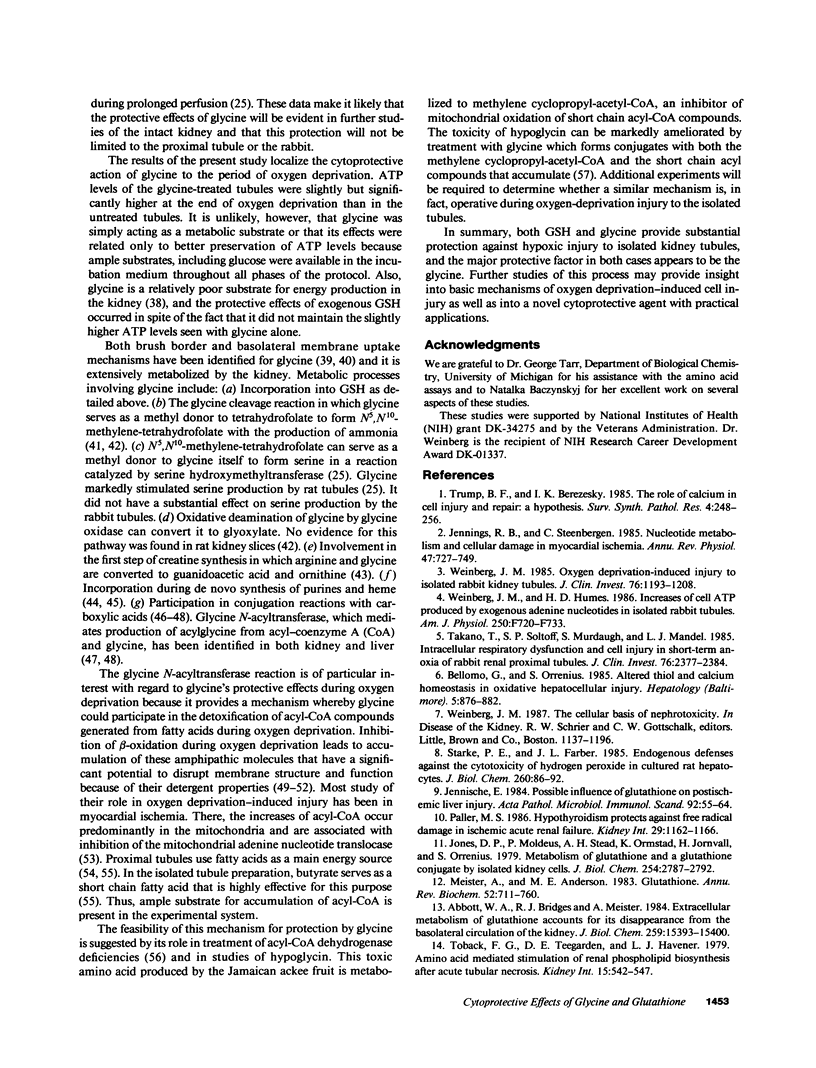
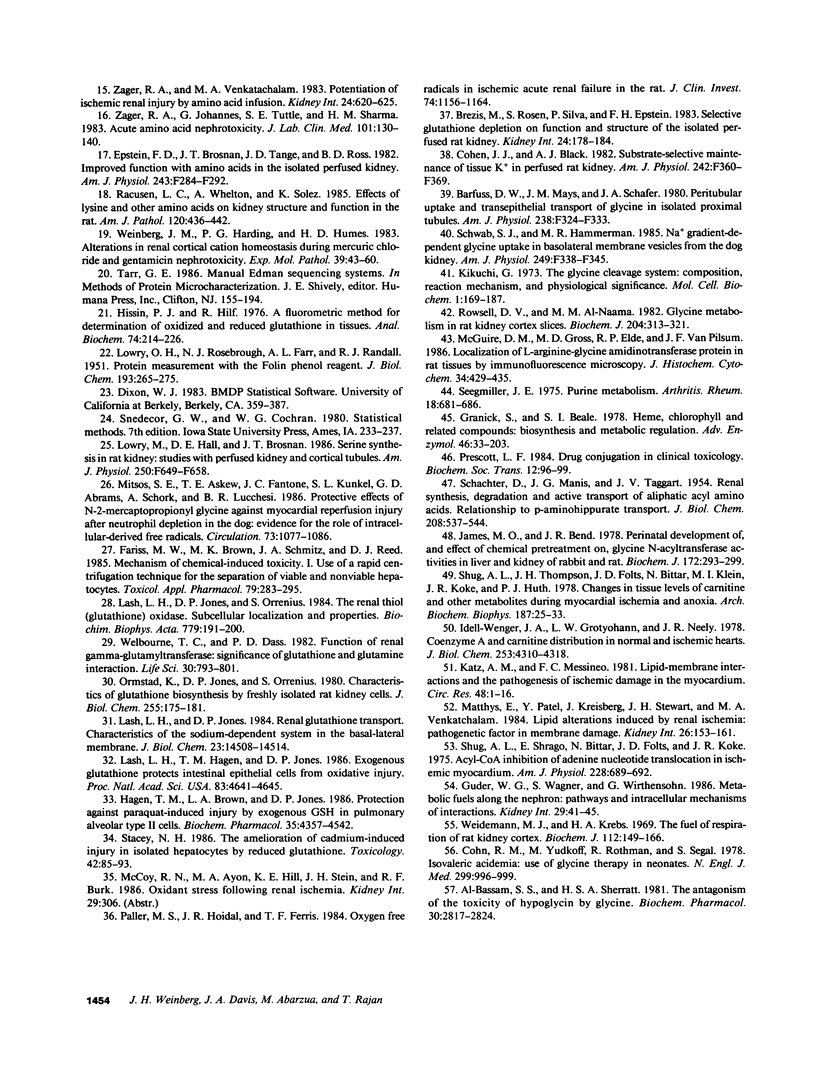
Selected References
These references are in PubMed. This may not be the complete list of references from this article.
- Abbott W. A., Bridges R. J., Meister A. Extracellular metabolism of glutathione accounts for its disappearance from the basolateral circulation of the kidney. J Biol Chem. 1984 Dec 25;259(24):15393–15400. [PubMed] [Google Scholar]
- Al-Bassam S. S., Sherratt H. S. The antagonism of the toxicity of hypoglycin by glycine. Biochem Pharmacol. 1981 Oct;30(20):2817–2824. doi: 10.1016/0006-2952(81)90420-2. [DOI] [PubMed] [Google Scholar]
- Barfuss D. W., Mays J. M., Schafer J. A. Peritubular uptake and transepithelial transport of glycine in isolated proximal tubules. Am J Physiol. 1980 Apr;238(4):F324–F333. doi: 10.1152/ajprenal.1980.238.4.F324. [DOI] [PubMed] [Google Scholar]
- Bellomo G., Orrenius S. Altered thiol and calcium homeostasis in oxidative hepatocellular injury. Hepatology. 1985 Sep-Oct;5(5):876–882. doi: 10.1002/hep.1840050529. [DOI] [PubMed] [Google Scholar]
- Brezis M., Rosen S., Silva P., Epstein F. H. Selective glutathione depletion on function and structure of the isolated perfused rat kidney. Kidney Int. 1983 Aug;24(2):178–184. doi: 10.1038/ki.1983.142. [DOI] [PubMed] [Google Scholar]
- CHU T. C., CHU E. J. H. Paper chromatography of methyl esters of dicarboxylic porphyrins. J Biol Chem. 1954 Jun;208(2):537–541. [PubMed] [Google Scholar]
- Cohen J. J., Black A. J. Substrate-selective maintenance of tissue K+ in perfused rat kidney. Am J Physiol. 1982 Apr;242(4):F360–F369. doi: 10.1152/ajprenal.1982.242.4.F360. [DOI] [PubMed] [Google Scholar]
- Cohn R. M., Yudkoff M., Rothman R., Segal S. Isovaleric acidemia: use of glycine therapy in neonates. N Engl J Med. 1978 Nov 2;299(18):996–999. doi: 10.1056/NEJM197811022991807. [DOI] [PubMed] [Google Scholar]
- Epstein F. H., Brosnan J. T., Tange J. D., Ross B. D. Improved function with amino acids in the isolated perfused kidney. Am J Physiol. 1982 Sep;243(3):F284–F292. doi: 10.1152/ajprenal.1982.243.3.F284. [DOI] [PubMed] [Google Scholar]
- Fariss M. W., Brown M. K., Schmitz J. A., Reed D. J. Mechanism of chemical-induced toxicity. I. Use of a rapid centrifugation technique for the separation of viable and nonviable hepatocytes. Toxicol Appl Pharmacol. 1985 Jun 30;79(2):283–295. doi: 10.1016/0041-008x(85)90350-3. [DOI] [PubMed] [Google Scholar]
- Granick S., Beale S. I. Hemes, chlorophylls, and related compounds: biosynthesis and metabolic regulation. Adv Enzymol Relat Areas Mol Biol. 1978;46:33–203. doi: 10.1002/9780470122914.ch2. [DOI] [PubMed] [Google Scholar]
- Guder W. G., Wagner S., Wirthensohn G. Metabolic fuels along the nephron: pathways and intracellular mechanisms of interaction. Kidney Int. 1986 Jan;29(1):41–45. doi: 10.1038/ki.1986.6. [DOI] [PubMed] [Google Scholar]
- Hagen T. M., Brown L. A., Jones D. P. Protection against paraquat-induced injury by exogenous GSH in pulmonary alveolar type II cells. Biochem Pharmacol. 1986 Dec 15;35(24):4537–4542. doi: 10.1016/0006-2952(86)90776-8. [DOI] [PubMed] [Google Scholar]
- Hissin P. J., Hilf R. A fluorometric method for determination of oxidized and reduced glutathione in tissues. Anal Biochem. 1976 Jul;74(1):214–226. doi: 10.1016/0003-2697(76)90326-2. [DOI] [PubMed] [Google Scholar]
- Idell-Wenger J. A., Grotyohann L. W., Neely J. R. Coenzyme A and carnitine distribution in normal and ischemic hearts. J Biol Chem. 1978 Jun 25;253(12):4310–4318. [PubMed] [Google Scholar]
- James M. O., Bend J. R. Perinatal development of, and effect of chemical pretreatment on, glycine N-acyltransferase activities in liver and kidney of rabbit and rat. Biochem J. 1978 May 15;172(2):293–299. doi: 10.1042/bj1720293. [DOI] [PMC free article] [PubMed] [Google Scholar]
- Jennings R. B., Steenbergen C., Jr Nucleotide metabolism and cellular damage in myocardial ischemia. Annu Rev Physiol. 1985;47:727–749. doi: 10.1146/annurev.ph.47.030185.003455. [DOI] [PubMed] [Google Scholar]
- Jennische E. Possible influence of glutathione on postischemic liver injury. Acta Pathol Microbiol Immunol Scand A. 1984 Jan;92(1):55–64. doi: 10.1111/j.1699-0463.1984.tb04377.x. [DOI] [PubMed] [Google Scholar]
- Jones D. P., Moldfus P., Stead A. H., Ormstad K., Jörnvall H., Orrenius S. Metabolism of glutathione and a glutathione conjugate by isolated kidney cells. J Biol Chem. 1979 Apr 25;254(8):2787–2792. [PubMed] [Google Scholar]
- Katz A. M., Messineo F. C. Lipid-membrane interactions and the pathogenesis of ischemic damage in the myocardium. Circ Res. 1981 Jan;48(1):1–16. doi: 10.1161/01.res.48.1.1. [DOI] [PubMed] [Google Scholar]
- Kikuchi G. The glycine cleavage system: composition, reaction mechanism, and physiological significance. Mol Cell Biochem. 1973 Jun 27;1(2):169–187. doi: 10.1007/BF01659328. [DOI] [PubMed] [Google Scholar]
- LOWRY O. H., ROSEBROUGH N. J., FARR A. L., RANDALL R. J. Protein measurement with the Folin phenol reagent. J Biol Chem. 1951 Nov;193(1):265–275. [PubMed] [Google Scholar]
- Lash L. H., Hagen T. M., Jones D. P. Exogenous glutathione protects intestinal epithelial cells from oxidative injury. Proc Natl Acad Sci U S A. 1986 Jul;83(13):4641–4645. doi: 10.1073/pnas.83.13.4641. [DOI] [PMC free article] [PubMed] [Google Scholar]
- Lash L. H., Jones D. P., Orrenius S. The renal thiol (glutathione) oxidase. Subcellular localization and properties. Biochim Biophys Acta. 1984 Jun 25;779(2):191–200. doi: 10.1016/0304-4157(84)90008-x. [DOI] [PubMed] [Google Scholar]
- Lash L. H., Jones D. P. Renal glutathione transport. Characteristics of the sodium-dependent system in the basal-lateral membrane. J Biol Chem. 1984 Dec 10;259(23):14508–14514. [PubMed] [Google Scholar]
- Lowry M., Hall D. E., Brosnan J. T. Serine synthesis in rat kidney: studies with perfused kidney and cortical tubules. Am J Physiol. 1986 Apr;250(4 Pt 2):F649–F658. doi: 10.1152/ajprenal.1986.250.4.F649. [DOI] [PubMed] [Google Scholar]
- Matthys E., Patel Y., Kreisberg J., Stewart J. H., Venkatachalam M. Lipid alterations induced by renal ischemia: pathogenic factor in membrane damage. Kidney Int. 1984 Aug;26(2):153–161. doi: 10.1038/ki.1984.149. [DOI] [PubMed] [Google Scholar]
- McGuire D. M., Gross M. D., Elde R. P., van Pilsum J. F. Localization of L-arginine-glycine amidinotransferase protein in rat tissues by immunofluorescence microscopy. J Histochem Cytochem. 1986 Apr;34(4):429–435. doi: 10.1177/34.4.3512696. [DOI] [PubMed] [Google Scholar]
- Meister A., Anderson M. E. Glutathione. Annu Rev Biochem. 1983;52:711–760. doi: 10.1146/annurev.bi.52.070183.003431. [DOI] [PubMed] [Google Scholar]
- Mitsos S. E., Askew T. E., Fantone J. C., Kunkel S. L., Abrams G. D., Schork A., Lucchesi B. R. Protective effects of N-2-mercaptopropionyl glycine against myocardial reperfusion injury after neutrophil depletion in the dog: evidence for the role of intracellular-derived free radicals. Circulation. 1986 May;73(5):1077–1086. doi: 10.1161/01.cir.73.5.1077. [DOI] [PubMed] [Google Scholar]
- Ormstad K., Jones D. P., Orrenius S. Characteristics of glutathione biosynthesis by freshly isolated rat kidney cells. J Biol Chem. 1980 Jan 10;255(1):175–181. [PubMed] [Google Scholar]
- Paller M. S., Hoidal J. R., Ferris T. F. Oxygen free radicals in ischemic acute renal failure in the rat. J Clin Invest. 1984 Oct;74(4):1156–1164. doi: 10.1172/JCI111524. [DOI] [PMC free article] [PubMed] [Google Scholar]
- Paller M. S. Hypothyroidism protects against free radical damage in ischemic acute renal failure. Kidney Int. 1986 Jun;29(6):1162–1166. doi: 10.1038/ki.1986.122. [DOI] [PubMed] [Google Scholar]
- Prescott L. F. Drug conjugation in clinical toxicology. Biochem Soc Trans. 1984 Feb;12(1):96–99. doi: 10.1042/bst0120096. [DOI] [PubMed] [Google Scholar]
- Racusen L. C., Whelton A., Solez K. Effects of lysine and other amino acids on kidney structure and function in the rat. Am J Pathol. 1985 Sep;120(3):436–442. [PMC free article] [PubMed] [Google Scholar]
- Rowsell E. V., Al-Naama M. M., Rowsell K. V. Glycine metabolism in rat kidney cortex slices. Biochem J. 1982 Apr 15;204(1):313–321. doi: 10.1042/bj2040313. [DOI] [PMC free article] [PubMed] [Google Scholar]
- Schwab S. J., Hammerman M. R. Na+ gradient-dependent glycine uptake in basolateral membrane vesicles from the dog kidney. Am J Physiol. 1985 Sep;249(3 Pt 2):F338–F345. doi: 10.1152/ajprenal.1985.249.3.F338. [DOI] [PubMed] [Google Scholar]
- Seegmiller J. E. Purine metabolism. Arthritis Rheum. 1975 Nov-Dec;18(6 Suppl):681–686. doi: 10.1002/art.1780180707. [DOI] [PubMed] [Google Scholar]
- Shug A. L., Shrago E., Bittar N., Folts J. D., Koke J. R. Acyl-CoA inhibition of adenine nucleotide translocation in ischemic myocardium. Am J Physiol. 1975 Mar;228(3):689–692. doi: 10.1152/ajplegacy.1975.228.3.689. [DOI] [PubMed] [Google Scholar]
- Shug A. L., Thomsen J. H., Folts J. D., Bittar N., Klein M. I., Koke J. R., Huth P. J. Changes in tissue levels of carnitine and other metabolites during myocardial ischemia and anoxia. Arch Biochem Biophys. 1978 Apr 15;187(1):25–33. doi: 10.1016/0003-9861(78)90003-6. [DOI] [PubMed] [Google Scholar]
- Stacey N. H. The amelioration of cadmium-induced injury in isolated hepatocytes by reduced glutathione. Toxicology. 1986 Dec 1;42(1):85–93. doi: 10.1016/0300-483x(86)90095-8. [DOI] [PubMed] [Google Scholar]
- Starke P. E., Farber J. L. Endogenous defenses against the cytotoxicity of hydrogen peroxide in cultured rat hepatocytes. J Biol Chem. 1985 Jan 10;260(1):86–92. [PubMed] [Google Scholar]
- Takano T., Soltoff S. P., Murdaugh S., Mandel L. J. Intracellular respiratory dysfunction and cell injury in short-term anoxia of rabbit renal proximal tubules. J Clin Invest. 1985 Dec;76(6):2377–2384. doi: 10.1172/JCI112250. [DOI] [PMC free article] [PubMed] [Google Scholar]
- Toback F. G., Teegarden D. E., Havener L. J. Amino acid-mediated stimulation of renal phospholipid biosynthesis after acute tubular necrosis. Kidney Int. 1979 May;15(5):542–547. doi: 10.1038/ki.1979.69. [DOI] [PubMed] [Google Scholar]
- Trump B. F., Berezesky I. K. The role of calcium in cell injury and repair: a hypothesis. Surv Synth Pathol Res. 1985;4(3):248–256. doi: 10.1159/000156978. [DOI] [PubMed] [Google Scholar]
- Weidemann M. J., Krebs H. A. The fuel of respiration of rat kidney cortex. Biochem J. 1969 Apr;112(2):149–166. doi: 10.1042/bj1120149. [DOI] [PMC free article] [PubMed] [Google Scholar]
- Weinberg J. M., Harding P. G., Humes H. D. Alterations in renal cortex cation homeostasis during mercuric chloride and gentamicin nephrotoxicity. Exp Mol Pathol. 1983 Aug;39(1):43–60. doi: 10.1016/0014-4800(83)90040-0. [DOI] [PubMed] [Google Scholar]
- Weinberg J. M., Humes H. D. Increases of cell ATP produced by exogenous adenine nucleotides in isolated rabbit kidney tubules. Am J Physiol. 1986 Apr;250(4 Pt 2):F720–F733. doi: 10.1152/ajprenal.1986.250.4.F720. [DOI] [PubMed] [Google Scholar]
- Weinberg J. M. Oxygen deprivation-induced injury to isolated rabbit kidney tubules. J Clin Invest. 1985 Sep;76(3):1193–1208. doi: 10.1172/JCI112075. [DOI] [PMC free article] [PubMed] [Google Scholar]
- Welbourne T. C., Dass P. D. Function of renal gamma-glutamyltransferase: significance of glutathione and glutamine interactions. Life Sci. 1982 Mar 8;30(10):793–801. doi: 10.1016/0024-3205(82)90591-4. [DOI] [PubMed] [Google Scholar]
- Zager R. A., Johannes G., Tuttle S. E., Sharma H. M. Acute amino acid nephrotoxicity. J Lab Clin Med. 1983 Jan;101(1):130–140. [PubMed] [Google Scholar]
- Zager R. A., Venkatachalam M. A. Potentiation of ischemic renal injury by amino acid infusion. Kidney Int. 1983 Nov;24(5):620–625. doi: 10.1038/ki.1983.202. [DOI] [PubMed] [Google Scholar]


